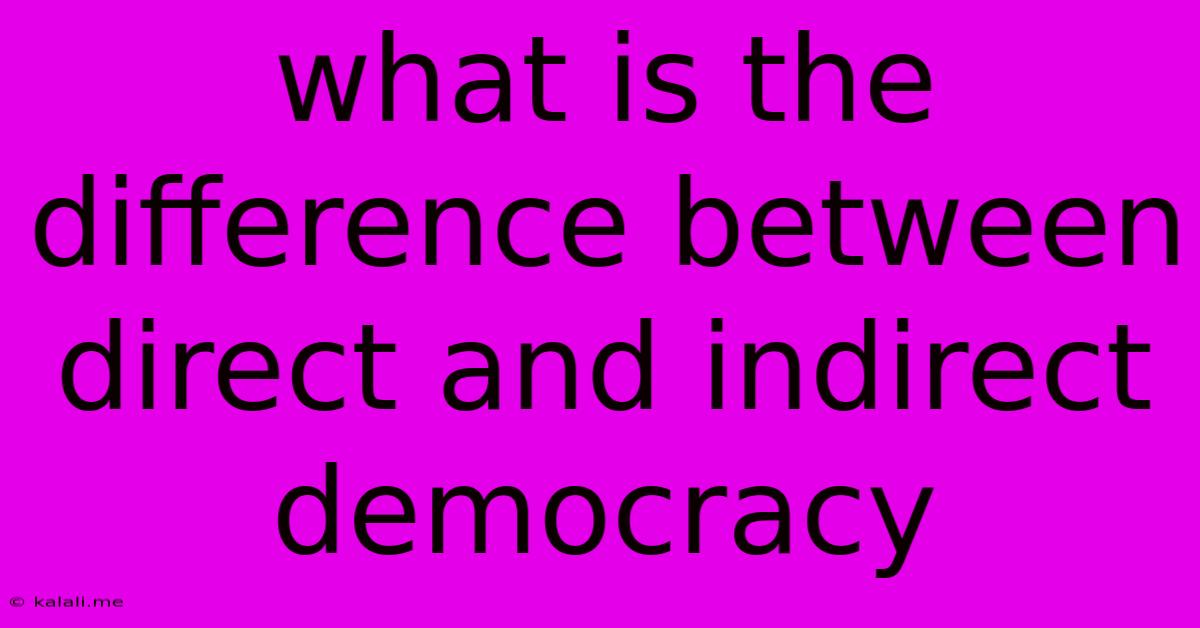What Is The Difference Between Direct And Indirect Democracy
Kalali
Jun 12, 2025 · 3 min read

Table of Contents
Direct vs. Indirect Democracy: Understanding the Differences
Understanding the nuances between direct and indirect democracy is crucial for anyone interested in political systems and governance. While both aim for citizen participation in decision-making, their approaches differ significantly. This article will explore the core distinctions between these two forms of democracy, highlighting their advantages and disadvantages. It's a crucial topic for anyone seeking a deeper understanding of how governments function and the varying degrees of citizen involvement.
Direct democracy, also known as pure democracy, is a system where citizens directly participate in making laws and decisions. This contrasts sharply with indirect democracy (also known as representative democracy), where citizens elect representatives to make decisions on their behalf. The key difference boils down to the level of citizen involvement in the actual decision-making process.
Direct Democracy: The People's Voice, Directly Heard
In a direct democracy, citizens vote directly on policies and laws. This can manifest in various ways:
- Referendums and Initiatives: Citizens vote on specific proposals or initiatives placed on the ballot. This allows for direct influence on policy.
- Citizen Assemblies: Randomly selected citizens gather to discuss and decide on issues, often acting as a form of deliberative democracy.
- Town Hall Meetings: Open forums where citizens can voice their opinions and directly interact with elected officials.
Advantages of Direct Democracy:
- Increased Citizen Engagement: Direct involvement fosters a stronger sense of civic duty and responsibility.
- Greater Accountability: Elected officials are held more directly accountable to the public will.
- More Responsive Government: Policies directly reflect the preferences of the citizenry.
Disadvantages of Direct Democracy:
- Inefficient and Time-Consuming: Managing large-scale votes on every issue can be impractical and slow.
- Susceptible to Manipulation: Polls can be easily influenced by misinformation and propaganda.
- Tyranny of the Majority: Minority rights can be overlooked in the pursuit of majority rule. This is a key concern and requires careful consideration of protections for minority groups.
- Lack of Expertise: Citizens may lack the specialized knowledge needed to make informed decisions on complex issues.
Indirect Democracy: Representation and Accountability
Indirect democracy, the most common form of government in the modern world, involves citizens electing representatives to govern on their behalf. These representatives are accountable to the electorate through periodic elections.
- Parliamentary Systems: Citizens elect representatives to a parliament, which then forms a government.
- Presidential Systems: Citizens elect a president, who heads the executive branch, and also elect representatives to a legislature.
Advantages of Indirect Democracy:
- Efficient Decision-Making: Representatives can make decisions more quickly and efficiently than direct votes.
- Specialized Knowledge: Elected officials often possess greater expertise in policy areas.
- Protection of Minority Rights: Representative systems usually include mechanisms to protect minority interests.
Disadvantages of Indirect Democracy:
- Reduced Citizen Engagement: Citizens may feel less connected to the political process.
- Potential for Corruption: Representatives may act in their own self-interest rather than the public interest.
- Limited Accountability: Representatives may be less responsive to the needs of their constituents.
- Influence of Special Interest Groups: Powerful lobbies and interest groups can exert undue influence on elected officials.
Conclusion: A Spectrum of Participation
Direct and indirect democracy represent different points on a spectrum of citizen participation. While pure direct democracy is rare, many modern democracies incorporate elements of both, seeking to balance efficiency with citizen involvement. The ongoing debate about optimal levels of participation underscores the enduring importance of understanding the strengths and weaknesses of each approach. Ultimately, the “best” system depends on a multitude of factors, including the size and complexity of the society, its cultural norms, and the specific challenges it faces.
Latest Posts
Latest Posts
-
Is Ifsc And Swift Code Same
Jun 13, 2025
-
Which Of The Following Is An Example Of Symmetric Encryption
Jun 13, 2025
-
Which Of The Following Statements Are True Regarding Rfid
Jun 13, 2025
-
Least Common Multiple Of 6 5 And 7
Jun 13, 2025
-
Which Of The Following Produce Antibodies
Jun 13, 2025
Related Post
Thank you for visiting our website which covers about What Is The Difference Between Direct And Indirect Democracy . We hope the information provided has been useful to you. Feel free to contact us if you have any questions or need further assistance. See you next time and don't miss to bookmark.